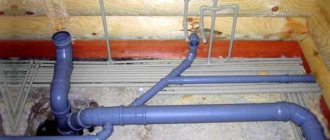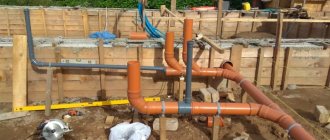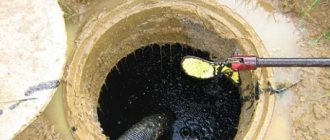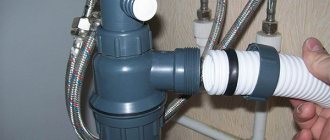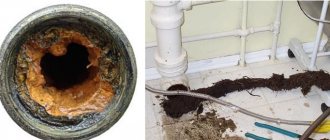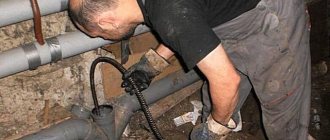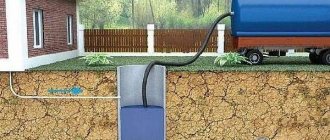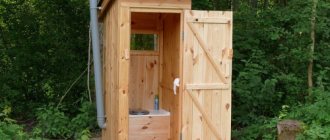In a country house, summer residents gradually create the most acceptable comfortable conditions. This also applies to the construction of a sewerage system. But such a highway is built when the walls and roof of the house are erected; it is not cheap, and a lot of effort is required. When construction is underway, there is no time or opportunity to make a thorough sewer system; they use ready-made toilets without sewerage, which are optimal for constant use.
What do designers offer?
There are no restrictions on arranging a bathroom in a wooden house. But ethno-styles look more organic:
- Provence He is characterized by the use of pastel colors and ceramic elements. Floral patterns on tiles would be appropriate;
- rustic. The difference is the imitation of the raw surface of natural materials in combination with floral prints;
- rustic. Involves the use of wood in all variations. For rooms with high humidity, either specially treated wooden lining or materials that only imitate natural wood are used.
But modern styles will also be appropriate if they do not stand out from the general concept of the whole house.
Thanks to the exquisite simplicity and texture of the material, harmony in proportions, environmental friendliness and aesthetics, it is these factors that wooden houses have gained high popularity in private housing construction. This trend, which is relevant today, will only develop after a certain period, since a house made from natural raw materials has high performance properties and is relatively inexpensive when compared with brick buildings. Many, realizing the advantages of a log house, are prejudiced by the fact that such a building can be equipped with all the engineering and communication networks present in brick or block houses and apartments.
The concept of incompatibility of a log house with the plumbing installation in it and all the amenities is often associated with a misunderstanding that such a structure is a full-fledged residential structure. You can live in such a building with all the technical amenities, as in an apartment, but you should worry about this yourself, as well as about their functioning and cleaning, without shifting these problems to utility organizations. Note that this is even for the better, because it will be more reliable.
In our article we will talk about the construction and arrangement of a plumbing room in a wooden house, we will discuss the specifics of the organization and important nuances that we may encounter during the work.
Do-it-yourself construction of a country toilet with a backlash-closet with a cesspool with photo
The design and arrangement of a country toilet with a cesspool can be chosen based on the availability of certain building materials on the farm. If the farm does not have boards for constructing a cabin, then you can first build a wooden frame, wrapping it with opaque film or finishing it with roofing felt.
As you can see in the photo, a distinctive feature of a backlash closet is the presence of exhaust ventilation for the cesspool:
A ventilation riser made of asbestos-cement pipe with a diameter of 100-150 mm should be mounted to the rear wall of the booth. To do this, you can build a box made of boards. The width of each side of such a box should be approximately 150 mm. When performing exhaust ventilation of the cesspool, it is necessary to ensure the tightness of all connections, which is the main condition for quality work.
The cesspool for the backlash closet is a pit up to 1.5 m deep, the bottom of which, for ease of cleaning, should be made with a slight slope towards the hatch. A pit toilet can be sealed or filtered. Its design depends on specific conditions. For a large family, it is recommended to build a cesspool with a volume of at least 2 m, and it must be airtight. This type of cesspool is considered the most environmentally friendly, as it does not pollute the soil, but it requires regular cleaning. A filtered cesspool can be cleaned much less frequently, but waste from it will in any case seep into the ground. Such a cesspool is allowed to be installed only if the daily volume of waste is up to 1 m. In addition, when constructing it, it is recommended to use concrete rings for the well.
The top of the cesspool should be insulated so that it does not freeze. You must first lay wooden or reinforced concrete beams above it, and then install and secure the toilet stall on them.
If there is no concrete floor above the pit, the open space should be tightly covered with boards, and roofing material should be placed on top of them.
The bottom of the cesspool should be located 1 m above the maximum (autumn-spring) groundwater level.
Building a toilet with a retractable bucket is a more economical option, but it must be taken into account that feces removed from such a toilet cannot be used as fertilizer; they need to be pre-composted. Under no circumstances should you construct an overflow pit for a toilet that resembles a septic tank and consists of concrete rings or other material, but without a bottom. This design can lead to contamination of groundwater by runoff.
Types of toilet designs
Before you start building a warm toilet in your country house, you need to decide on its type. Please take into account the requirements described above. The types of this sanitary and hygienic product may be as follows.
Equipped with a cesspool. The most common and simple structure. The cesspool is no more than one and a half meters deep. A toilet house is erected on top of it. During use, waste accumulates and gradually decomposes.
If the hole is not deep enough and does not cope with the task, then there are two options for solving the problem. The first of them involves demolishing the structure and burying a hole. The second involves cleaning the pit with the help of vacuum cleaners or on your own.
Powder closet. Application is convenient in areas with nearby water sources. In this case, there is no need for a cesspool, and it is replaced by a specially equipped container, which is placed directly under the toilet seat. The use of various powders allows you to remove unpleasant odors. Use dry peat, sawdust or ash. This event is similar to powdering, which gives the design its name.
Powder closet
When the container is filled with sewage, its contents are removed to a suitable place. Over time, compost turns into a wonderful fertilizer.
Backlash closet. The design of such a structure requires the presence of a sealed cesspool. Removal of accumulated sewage occurs using special equipment. Most often, such a bathroom is located in a house near the outer wall, and the cesspool is located on the outside of the same wall. The flow of wastewater into it is carried out through a pipe. The pit is constructed with a slope away from the house, which simplifies its cleaning.
Dry toilet. In essence, such a bathroom is a modern modernized powder closet. The difference between these structures is the replacement of peat or sawdust with microorganisms. When installing a dry closet, there is no need to build any structure, since it is a ready-to-use device. There is a wide selection of dry closets in sizes and shapes, which makes it possible to operate the device in the home. For the functioning of this toilet, it becomes necessary to acquire microorganisms. The advantage is the receipt of valuable fertilizer as a result of the decomposition of sewage by biological means.
Dry toilet
Chemical toilet. Its difference from a dry toilet lies in the means that processes wastewater. The use of chemical reagents makes the contents of the toilet unsuitable for further use.
Peat toilet. According to the principle of operation, it is similar to the powder closet, but somewhat modernized. This bathroom resembles a traditional toilet, the cistern of which is filled with dry peat. When using the device, dust is powdered. Often such a structure is installed in a house, having previously organized high-quality ventilation.
How to organize the operation of septic tanks in winter
If the operation of a dry toilet in the summer does not raise any questions, then what should you do in the country with a toilet without a sewer in the winter?
- First of all, you need to monitor the process of emptying the bottom drawer and take it out more often. On cold frosty days and especially at night, the structure should not have a full tank.
- For protection, it is necessary to add harmless antifreeze to the water of a biological structure.
- If possible, you need to install a warm toilet without sewerage, that is, heated. They can easily tolerate temperatures down to -60 degrees.
The heated dry closet cabin is insulated with a special material, and an electric heating device is built into the tank. The disadvantage of this design is the need for a constant connection to the electrical network. Also, the cabins are quite expensive and not affordable for many. When leaving sewerage equipment for the winter, care should be taken to preserve it. To do this, active bacteria are placed in an empty tank. If necessary, you can seek help from professionals.
One of the buildings reviewed and selected will provide comfortable living in a country house. You can purchase any of the designs in a specialized store. If a toilet without a sewer is not available in nearby stores, you can consider purchasing it online.
Add site to bookmarks
Conclusion: a peat toilet is one of the best compact options for a private country house. All waste can be disposed of as an excellent, environmentally friendly fertilizer.
Choosing a location for a country toilet
When organizing an outdoor toilet in your country house, you should adhere to the rules governing construction. More stringent requirements apply to structures with a cesspool. According to sanitary standards, the space allocated for the toilet must meet the conditions described below.
Its location is removed at a distance of more than 25 m from any source of water.
It is important to choose the right place for the toilet
If there is a slope of the terrain on the site, the installation site of the toilet should be lower than the source of water intake. This prevents the penetration of wastewater into the source.
The close location of the building to a neighbor's garden can cause discomfort, so it must be installed at a distance of at least one meter from the border of the plots, and the door should not open in the direction of the neighbors.
The toilet is located in a remote location from all objects located on the site. This applies not only to residential buildings, but also to barns, summer showers, cellars, as well as trees and buildings where pets are kept.
The choice of the type of toilet design is decisively influenced by the depth at which the groundwater lies. There are no restrictions if they are located on a horizon whose depth exceeds 2.5 m. Otherwise, installing a toilet equipped with a cesspool is not allowed.
If it is planned to install a structure that provides isolation of the soil from runoff, then some of the restrictions are removed.
Poor ventilation
Poor ventilation contributes to air stagnation in the toilet or bathroom, as a result of which they are filled with fumes from the sewer, which is not pleasant for residents. Natural draft hoods are often used in hygiene rooms, but they are ineffective because they regularly become clogged with debris.
Experts recommend installing forced ventilation devices operating from a 220V network. They quickly remove not only unpleasant odors from the room, but also moisture after taking water procedures.
To check the natural hood for functionality, you can use a candle or a piece of paper. If ventilation occurs at the proper level, the sheet will stick to the grate, and the flame from the candle will deviate towards it.
Working inside a toilet and releasing sewer pipes
To make a toilet in a private house
with a concrete floor, it will be necessary to open part of the screed. To do this, you can use a hammer drill or a hammer. Depending on the height of the floor relative to the ground level, you need to go 30-40 centimeters deeper. First, we determine the exact future location of the toilet - it is chosen arbitrarily, based on the parameters of the room and sound logic. Then we open a trench the width of the pipe from the place where the pipe will come out of the floor to the place where it will go in the direction of the drainage pit or septic tank. Using a hammer drill, we make a hole in the wall at this level slightly larger than the width of the pipe.
Choosing a location for a country toilet
But for many other applications and locations, you now have the latest compact composting toilet as a modern hygienic solution without the added chemicals or other additives like regular camping toilets with this dry cabinet.
The particularly robust design allows for safe biolocus sessions. While the droppings go directly into a collection container lined with a foil bag, the urine is discharged through a hose into an outer container. Its liquid contents can either be disposed of normally as usual or distributed as fertilizer in a tenfold dilution. Dryers are not really necessary due to the separation in the litter box.
After installing the drain pipe (diameter 100-120) and installing the corner joint, releasing it in the toilet upwards just above floor level, fill the remaining space with concrete and let it set. Do not forget about the slope, so it is better to do the filling after the installation and connection of the entire sewer pipe with the septic tank is completed. The trench in which the pipe was laid is filled with earth. If you use steel pipes, then you do not need to further strengthen them. But the plastic pipe is afraid of soil subsidence, so it is necessary to strengthen it. It is fashionable to use a steel case, but this is not economical.
Roof and floor
Subsequent garden composting of course also includes other organic material. This reliably prevents the formation of odors. The opening in the collection container is hidden by a tight-fitting lid that opens when the toilet seat is loaded. The silent fan operates continuously and creates an air flow that passes through the exhaust duct into the open air. The vent pipe is directed outward or connected to an existing vent. The existing lattice cap prevents birds and insects from entering the tube.
Another way out is to pre-fill the screed at the bottom of the trench, strengthening it with steel reinforcement. You can also pour small sides under the formwork, slightly higher in height than the thickness of the pipe. The result is a concrete case, which is covered on top with a tarred board or strips of steel 3-4 mm thick. Everything is covered with earth on top and lightly compacted. This way the pipe will be under reliable protection.
Instead of pipes, flexible hoses can naturally also be used in confined spaces. A convenient alternative for every bathroom with a new design and new design. The powerful fan for 230 V mains connection is adjusted in two stages, the 12 V version has only one stage, the non-electric model depends on nature. The hygienic valve and the rotating mechanism for optimal use of the volume of the collection container automatically provide their services when used. The villa combines very compact dimensions with convenience and long periods of downtime.
Reagent types
Odorless liquid chemical toilets for summer cottages can be:
- Bacterial . They are preferable; the decomposition of feces occurs due to the vital activity of microorganisms, so the waste can be used as fertilizer in the beds.
- Formaldehyde . The cheapest, but with a high hazard class, since formaldehyde is a toxic liquid and is used to preserve corpses. Disposal of waste near the house or bodies of water is prohibited, so when purchasing this type of dry closet you need to think about where to store the end result.
- Ammonievs . The liquid is safe and decomposes into harmless compounds in seven days.
All chemical and biological processes take place without the release of gas.
Example
Sanitation Equipment Limited Mr. Little Mini 18" is a Chinese product, manufactured using Canadian technology. The volume of the receiver is 24 l , the tank for reagent water is up to 15 l . All parts are connected with latches on the sides.
The drainage system is carefully thought out; liquid flows from both sides of the bowl , which saves reagents and washes away waste well. A portable model that does not require a special room or additional installation. Suitable for use by 4-7 people for several weeks. Price – from 8,000 rubles.
The case is equipped with 2 indicators, each showing the filling of “its” container. One of the disadvantages of a dry closet is that it is not very convenient to remove accumulated waste.
Which toilet is better to make in the country?
The arrangement of any summer cottage should begin with the construction of a toilet, making it the first and most important building on the garden plot. If the site is needed only for spending weekends in nature in the summer, then you can build a relatively light structure from scrap materials using simple tools. If the dacha involves permanent residence or long-term stay, then it is necessary to provide for the construction of a more permanent toilet structure.
What types of country toilets are there and what are their advantages? Most often, in summer cottages there is no sewerage system, so in such cases, yard toilets are mainly built. Using such a toilet can cause some inconvenience, especially in inclement weather. There are also certain advantages of a yard toilet: due to its location away from the country house, there are no unpleasant odors in living quarters.
If you have not yet decided which toilet is best to make in your dacha, you will have to choose from three design options: powder closets, toilets with a cesspool or with a retractable bucket.
Look at photos of different types of country toilets before you start choosing a design:
A country toilet stall is most often made of wood, giving it various shapes, even cone-shaped. It is this form that is convenient for placing drawers for storing peat, sawdust, ash, etc. in the extended base of the toilet.
It is recommended to make a country toilet cubicle from boards or light boards tightly fitted to each other. This type of construction is the simplest and does not require a lot of money and time.
Which toilet to choose for your dacha is up to the owner of the site to decide. Remember that a yard is a waste collection area, so the design of the method of collection of this waste makes the determining difference in the options for these buildings.
Which toilet for a summer house is better, and what their differences are, you will find out on this page.
Methods for connecting a toilet to a sewer system
How exactly the toilet will be connected to the sewer riser depends on the design of the system. It is important to note that you should select the shape of the toilet basing on the collector system.
There are three main types:
- vertical - similar models of plumbing are in most cases found in old buildings, where the socket of the sewer pipes in the floor passes into a riser located under the ceiling of the room below. Today, cottage owners also choose such a connection, because... thanks to this, you can completely hide the sewer pipeline;
- direct – also allows you to remove communications from sight. The advantage of this approach is the possibility of installing the toilet at a short distance from the wall;
- an oblique connection option is used when it is important to ensure operation even in the event of damage or loss of tightness. Sometimes the owners of the premises decide to connect the toilet outlet directly to the riser, however, this increases the risk of leakage, so it is undesirable to implement this approach; it is better to use a special adapter.
Construction from scratch - restroom design
In this case, everything is simple, since toilets are provided for in the project and can be placed on each floor of the future house. It is advisable to provide their location in such a way that they have a single sewer riser, which will save time and material resources spent on construction. Everything will depend on the specific project and the layout of the house. It is advisable that toilets and bathrooms do not have common walls with living rooms. Ideally, these could be external walls, partitions with corridors or technical rooms. Also, toilets and bathrooms should not be located above living rooms.
Raw humus is removed only after a few months through the back flap. The seat ring is also made of this material and is therefore pleasantly warm. Thus, it is mainly suitable for unheated external toilets. The 200 l container allows one year of operation without emptying.
If kitchen waste is added occasionally, In the process of emptying almost the right compost "harvest" - depending on the length of stay. The leaking liquid is passed into an external canister. Occasional addition of bark increases composting efficiency.
Peat-sawdust options
An odorless peat toilet for a summer residence operates on the principle of composting. A peat mixture with sawdust and dolomite absorbs waste well. Peat consumption is only 1 kg per 10 liters . A dry closet is installed in a country house with mandatory ventilation.
The internal waste treatment process is based on the natural presence of bacteria in peat. The dry closet has a special dispenser where you need to add the dry fraction, which evenly covers the waste. The mixture is used efficiently; after cleaning the dry closet, it can be placed in compost.
The only disadvantage of a peat dry closet is the need to install an exhaust pipe if it is installed in a house.
Example
“Piteco 506” - does not need to be connected to communications, is made of polypropylene, equipped with a ventilation pipe, a peat bag with a volume of 30 liters . Peat must be loaded into the upper tank manually using a scoop. The waste goes into the container.
Install on a flat floor, think about the location of the exhaust pipe and drainage hose (liquid). The downside of the dry closet is that the kit does not include a hood for the hood; it must be purchased separately.
Price Piteco 506 – from 5,500 rubles.
